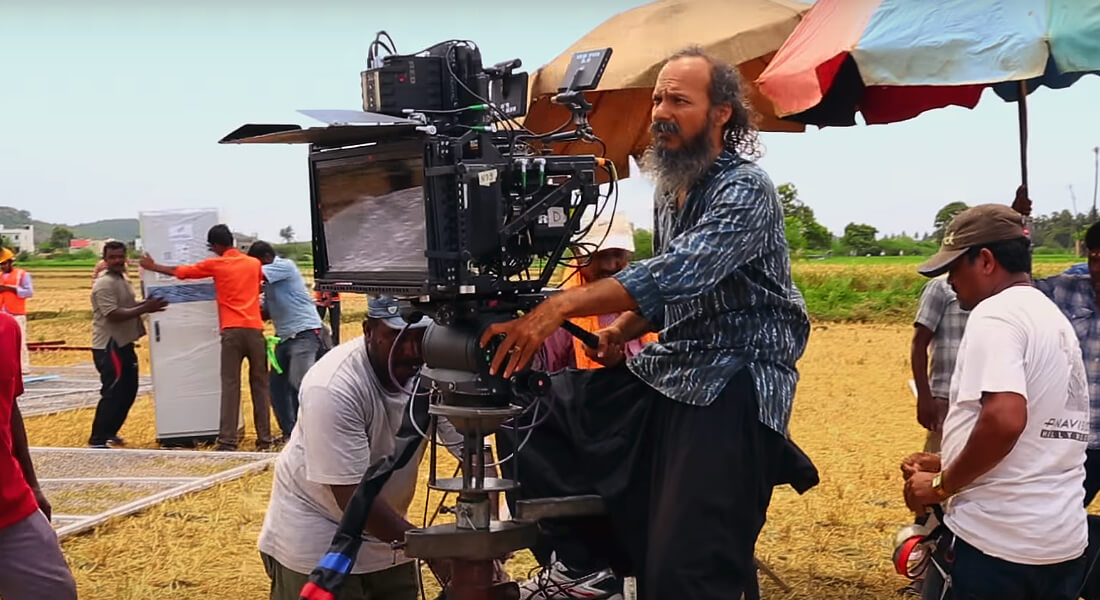
In coversation Nirav Shah
Apr 17 2020
NIRAV SHAH(“The way you light, is the way you live your life & the way you live your life is the way you light)
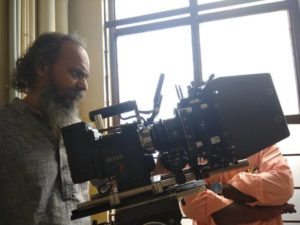
In conversation with Nirav Shah with SICA
1) We are interested to know more about the rain machine you purchased?
I bought it when I was shooting the movie Lakshmi. We were planning to shoot scenes in twilight, but the weather wasn’t favoring us. It was raining and it ruined that plan. So we had to change the twilight scenes to rain scenes. The rain machine made the process smooth for us, I personally felt we should find all the possible ways to make our life easier. We can create rain effect with 3 different intensities, let it be heavy downpour to soft rain. There is different heads, we can change then according to our desired effect. It works really efficiently, we save a lot of water than the old machine we commonly use.
2) The coming of RED Camera have changed phase of industry digitally. The fact that, you were first one to buy them too. In which basis, did you think it would work out well ? Also having in mind that the future will be digital.
Yes, it was already working well in still cameras. By the time RED came out, all the still photographers changed to digital. The only problem with Digital was you couldn’t shoot 24fps and resolution all was matter of time for them to bridge that. RED came up with a resolution of 4k with manual modes and I was seeing the RAW feature as the turning point, its gives more latitude like negative to work with it.
3) In the beginning, how did you compare RED Camera with the Films?
In the very beginning , it was never as good as films. The first movie I shot with RED was Thamizh Padam, that comedy movie didn’t actually need the strong visuals it was also a small budget movie. The RED Camera fitted the budget well. That movie was recreation of a lot of movies and lightings, so I thought it would be a good opportunity to try. While shooting Thamizh Padam, I was also working on Madarasapattinam parallely. The Camera had its own set of problems in the beginning, it used to look very sharp, very yellowish tone, but it was nothing something we couldn’t handle. It needed more effort in post-production. It was never close to films but it wasn’t bad I would say. The camera started advancing over time.
4) You have special capacities in handling digital. When everyone was trying to get the film look in digital cameras, you worked the other way round. You started exploring the unique factor in digital camera. Can you share us about that.
Yes, one thing we had to remember was, we will never be able to match the quality of films in digital and there was no point trying. So, I tried getting the best image possible and tell story in the best way, what I was trying was to control…the extra sharpness the digital had .I did try to match them to films, and did try to get the closest look possible. One thing, we were all used to that film look.
5) How did you handle the quality sharpness in digital cameras?
I control them mostly with lighting than lensing. Through lighting we create the roundness, I also see how the skin is showing, how the shadow falls. Harsh light will show off the pores in the skin but soft light would appear smooth on skin. During post, we have also added soft to the skin, very minimal. I shot Thamizh Padam and Kaaviya Thalaivan with RED Prime, I also had a set of Ultra Prime but found it too sharp. So, decided to go with Red Primes, with these we get a little softness in the skin. Almost all my digital films was shot with RED primes.
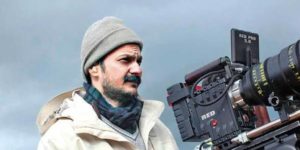
6) Your thoughts on the challenges we face while working on a small films and big films?
From what I have realized, there is no difference between small and big films. The pressure and challenges is there in any films.
“It’s like a poor man in pressure because he has no 100 rupees, and a rich guy be under pressure because he doesn’t have 10 rupees”
The pressure is the same. I feel there was more freedom doing smaller films. Big films they have big budget but we racing against time.
7) We have notice you as a very experimental Cinematographer when it came to Super Deluxe. The enveloping darkness with strong colors, was what the thought process behind that?
I came a a little later into the film. Director Kumararaja already had that mood and color he wanted in mind. The strong colors was in the costumes, art departments, I didn’t use much strong colors from my side. The frame was already strong with the colors. The only portion I used was the boys watching blue film. I used a tungsten light with a filter to create a warm tone coming into the house.
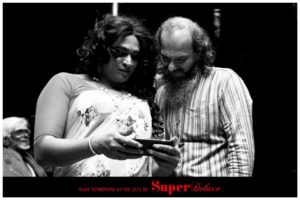
8) Super Deluxe had this biting darkness, very unique we would say. We have seen Anjali, but that was more glamourized kind of darkness. How did you achieve that?
If you less equipment, it’s easy to achieve. If you only have one light, you have to place that light in the right place. If you have a lot of lights you tend to go wrong. It was my first time shooting with Alexa and Ultra Prime. For me, it was a learning process getting used to it. Director Kumar Raj briefed me that he wanted to utilize the whole latitude of the sensor, from the burned out to 3 stops under. I was keen to place visual in a particular zonal system according to the scene and location.
9) As a visual author which was your favorite scene you shot in Super Deluxe?
I really enjoyed working in that film. My favorite scene is the church scene by Mysskin. That portion was a little challenging because I was only lighting through the window with no lights from the inside. I also like the intro scene of Vijay Sethupathi at his house.
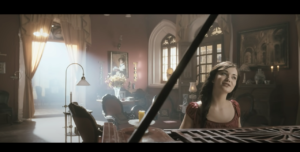
10) Madarasapattinam was the first movie that was shot with half set and graphics. At that point of time, there was very little guidance or reference too. How was the making process? You were very careful with every details.
We had a Mount Road set and Central Station ground floor set. Above that everything was graphics. We had very good CG team on board. They knew their job very well. We had huge green screen work, we had to buy the material cloth and dye it the same shade of green. The Director and the Art Director had a big role to play in bringing that period to life.
We wanted to take people to that period, if one thing is wrong they will come out of the mood and it would hurts the storytelling. So we took extra effort to make sure whatever that is in the frame has to be authentic or better off without them.
“If something is there is must be right or let it not be there”
11) On a typical shoot day, how is the process on shot spot? The working and planning process with the Director?
The process is different with every Director. Some of them like shooting in order, some have their shot division in mind. General process, I read the scene and figure out what the director has in mind and what should come through the screen. For instance, before lighting up a scene, we understand the mood of the scene, and the time frame for each scene.
12) Please enlighten us more about your relationship with the Directors? They are a few of them who you have worked together with for a number of films and have a good repo.
I would say it’s a very organic process. When you are happy with the Director work and they are with yours, it would come to you by every chance. When a Director is comfortable with a certain team, they want to continue working with them. They would have to worry a little less, because they know our work.
13) You redefined action genre through Dhoom , providing no perfect reference too. We only had few set of action sequence till that day. How did you execute the film ?
Dhoom was my third film in my career, I wanted to shot it very grungy. Once they brought in the bikes, they were all good looking. Then I knew it won’t work if I shot it that way. I wanted to keep in pacey, we shot them at the exact speed of the bikes. Not less or more that the actual. We figured out camera stabilization, had a very good car. We also got good roads, tracking cars. We never had proper mount for aerial shots too, I remember having them in my lap while shooting them.
14) Can you share us about your movie Banaras?
It’s one of my favorite film. We shot it in Banaras, 50 days shot. I was actually reacting to the place and space that was there. The city itself was so colorful and beautiful. It had a unique color from the stones to their clothes.
15) What lens was used to shoot Banaras?
I shot with ARRI 3, KOVA 40mm,50mm,75mm,100mm and HR zoom
16) During the making of Billa, the color black was the color prominently used throughout the film. We would love to know your thought process when you were pitched ?
Black portrays richness and class. Billa is a film that already had a version before. Everybody who is coming to the theatre knows the story, that was something we cannot change. So we wanted to give them a different experience, and drive them to want to come watch the film. The first decision we made was to cut out all the colors, and go with white, grey and black. Everything had to be within this colors. It limited the color palette for us and made a huge difference to the film. In DI, we further desaturated the colors at the parts where we didn’t have control over the colors.
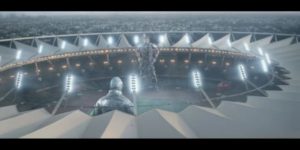
17) While working on big sets like Enthiran 2.0, how much time do you take to plan lighting and pre-light?
Generally, I like to pre-light or else it becomes very stressful. When the sets is being built, I visit the set few times. Whenever possible I bring along the Director along, to get glimpse of what they have in mind. Mostly I take a day to pre-light, max of two call sheets. I try to keep them easy, so if there is any changes of angle it must be able to be executed.
18) Share us more about the Pre-Visualization process for your movies ?
Oh yes, for 2.0 we spent a lot of time for Pre-Visualize. All the action sequence needed Pre-Visualization or else we would have wasted a lot of time, money and energy. Everybody needs to know what’s happening. Ayalaan movie also needed a lot of Pre-V sessions.
It’s possible to practice Pre-Visualization for any movies. You and the Director decide on the scene, get the shot division, the get a storyboard artist to sketch them, once the storyboard is done, then you pass it to the Pre-Visual team. To an extend you can also decide on the lenses but it’s not really precise.
19) When Enthiran 2.0 stadium sequence was shared to you, how did you conceive the whole sequence and the process ?
The whole action sequence was written down by the Director. He knew exactly what he wanted. So, we knew it has to be done in a stadium with that large crowd. We visited the location , decided the location. I was involved in the Pre- Vis, so we knew how we wanted to move the camera and it would look nice. I got the print out of every frame and listed all the equipment needed.

20) Share with us the experience of the 3D you worked with in Enthiran 2.0.
Everything was very new for me, it was an interesting process I would say. I got some books, visited some websites, spoke to teams who was also shooting in 3D. I got a lot of information and learning from that. Importantly we did test before the shoot. Important concern for me was quality of 3D should be best, so i decided to push the luminance level without affecting contrast and kept Stereoscopic glass quality to be new thoroughout the shoot.
Lighting was another major challenge i have to light for T 8 to bring depth and also a stop of light exposure factor/compensation for Stereoscopic glass.
21) Theiva Thirumagal’s scenes shot in Ooty had its own uniqueness. What was the work behind it ?
It was a very warm and secure relationship (father and daughter). It was full of love. So we decided to go with a lot of warm lights. We used a lot of warm light besides the daylight. In the Ooty portion, we inserted some warm color in every frame.
22) What goes behind the process of creating images?
It’s all the images you have in your mind, things you have learnt, things you have observed, everything you have read, it’s the sum of all of this.
23) What was the reason behind bringing in LUMA Panel to India?
While shooting a song for Kaaviya Thalaivan,in Santhome Blind School. I wanted a very soft light, like the moonlight coming through the sky. It was very difficult for me to achieve that, because it took time lighting on trance and diffusing them. It took a lot of time. We even tried creating our own light rig with all the kinoflo we had, still it was a difficult process. That was the day, I came across LUMA Panel which had 28 bulbs with large aperture .. It was very simple, you set up one or two lights you are done. You get a good amount of softness as well. It does not produce heat as well, it’s good for skin. I have used it as Key Light as well and gives amazing quality.
24) How was your experience working with Christopher Nolan?
I got a call, they were shooting in Bombay. They had 4 IMAX Camera, but they had 3 operators, so they needed for the 4th operator. I wanted to gain the experience of working in such films, and with people like that. It was back shooting in film again. I shot some sequence and was very happy it made it to the trailer.
“I felt like the whole reputation of India was on me”
25) How did you work for Thamizh Padam where you had to recreate movies that was shot in films, digitally?
I would say, I was actually recreating the lighting and framing. We couldn’t match the original for sure.
26) Would you agree that the light quality, skintone in India is different from other part of the globe..
I would agree to that. It’s the way we have been brought up, work ethics, and the influences on us. The lights we see around us, the lights here has a certain quality. The education process is different ,the way they are exposed to art, the whole learning process makes a different one.
Another factor is their skin tone. Their skin tone is so good that the whole lighting pattern changes. Lighting patterns differs for Caucasian skin and brown skin. Adding to it is the pollution is a major concern.
27) In Tamil industry, we do not have gaffer system. Why do you think we don’t have that system here?
It’s both the budget factor and the working culture. It would cost us a lot per day, getting that through a budget wouldn’t be possible. Gaffer system would actually lessen the burden out of our shoulder. We should train more gaffers into the industry.
28) While dealing with a gaffer what are the essential point to take in count?
First thing, we have to be sure about what we want. Provide them with some lighting references to ease the process. Let them know the quality of light you want as well.

29) Question from Dhoom2, Hirthik played 9 different roles with 9 looks in the movie. When we are working on a movie such, what are the points we need to keep in mind as a Cinematographer?
The most important point is to know how long each makeup would stay, then pressure will start building up. Some makeup would only stay for 30 minutes or an hour.
And you plan lighting according to the character. You light to enhance the details of the character; like the wrinkles or statue.
Heat of the light is very important…so try to use large source light that doesnt produce heat.
30) How was your experience working with the Virtual Camera for Enthiran 2.0?
It was very similar to using a regular camera, the only different is its connected to a system. They play a shot and you will be operating the camera, creating a movement for that shot. It stores your camera movement for the shot, in the end.
31) How did the monsoon scene happened in Pattiyal?
Chennai saw one of the wettest season during Pattiyal shooting was on…roads were flooded even Anand Cine Service campus was completely flooded. It was not planned. We know we can never create something like that, we just didn’t want to lose the opportunity. We didn’t want to let it go too. The team was very supportive, we went and start shooting without knowing want we needed. we sent a bus to get the camera over.
Without the support of the director and them getting enthusiasm about our idea all these wouldn’t be possible.
32) Note to our upcoming cinematographers.
My personal note would be; don’t rush, don’t hurry. You have to give it some time.
“If you eat a fruit before it ripes, it would never taste good”
Give yourself to ripe. You have to lay your foundation right.
Assist as many movies possible, you mature as you spend more time learning. If you want to be sure of your craft, you have to invest that much of time.
Compiled by : Pavetra Arumugham (BOFTA)
Edited by CJ Rajkumar (Author/Cinematographer)
